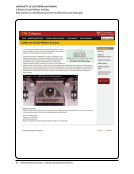SPEC Kit 347: Community-based Collections · 45
Decisions regarding description, accessioning and deaccessioning, preservation, access policies
Leadership for the collection is provided by the library’s Curator of Rare Books &Manuscripts with the assistance
of a dedicated Assistant Curator for the collection. They operate with support and input from an Advisory Board of
community members and scholars.
Make decisions about processing and cataloguing the collection and making it accessible to the public.
Staff in Special Collections and University Archives work together to manage the collection and provide access to it.
The archivist, who is an ex-officio member of the New England Historical society and the Commission on Archives for
the New England Annual Conference, educates the churches, organizes, preserves, and provides access to the public to
the records in the collection. The New England Historical Society provides funds for its maintenance and display of the
artifacts stored at the Lawrence, Massachusetts, offices and the records stored at Boston University School of Theology.
Decision making about the scope of the collection development policy is addressed with these groups. Discussion and
action on historic preservation and historic recognition of sites in the New England area of specific United Methodist
or Methodist Episcopal historical interest take place. Plaques are added to buildings at one or both of our semi-annual
meetings. Tours and information in the form of oral speakers and newsletter articles are disseminated among the New
England Annual Conference people interested in the history of Methodism in New England.
The BJE collects and processes collections University Archives is the holding repository, performs reference requests,
digitization, etc.
The board is the governing body and decides the activities of the archives.
The governing body is responsible for the submission of these materials. They are working to organize the materials
before they submit them in order to improve ingesting them.
The library has responsibility for staffing, for cataloging, for processing, for outreach, for space, and for
general maintenance.
The library is responsible for collection development, preservation, arrangement, description, outreach, and financial
decisions relating to the collections.
The University Archivist is responsible for approving all acquisitions of private collections, regardless of the donor
type (individual, institution, or community). Archivists are responsible for the archival appraisal of the collection, and
supervising the processing and arrangement and description of the collection. The processing and arrangement and
description may be done by a graduate student or an archivist.
The University Library works with the 501c3’s governing board to oversee the collection through the director.
There is an advisory Executive Council made up of community members and library representatives.
To arrange, preserve, and make available for use the contents of the archive.
We meet a few times each year to discuss the project’s goals and visions.
26. Has the governance structure for the collection changed since its acquisition? N=34
Yes 5 15%
No 29 85%
Decisions regarding description, accessioning and deaccessioning, preservation, access policies
Leadership for the collection is provided by the library’s Curator of Rare Books &Manuscripts with the assistance
of a dedicated Assistant Curator for the collection. They operate with support and input from an Advisory Board of
community members and scholars.
Make decisions about processing and cataloguing the collection and making it accessible to the public.
Staff in Special Collections and University Archives work together to manage the collection and provide access to it.
The archivist, who is an ex-officio member of the New England Historical society and the Commission on Archives for
the New England Annual Conference, educates the churches, organizes, preserves, and provides access to the public to
the records in the collection. The New England Historical Society provides funds for its maintenance and display of the
artifacts stored at the Lawrence, Massachusetts, offices and the records stored at Boston University School of Theology.
Decision making about the scope of the collection development policy is addressed with these groups. Discussion and
action on historic preservation and historic recognition of sites in the New England area of specific United Methodist
or Methodist Episcopal historical interest take place. Plaques are added to buildings at one or both of our semi-annual
meetings. Tours and information in the form of oral speakers and newsletter articles are disseminated among the New
England Annual Conference people interested in the history of Methodism in New England.
The BJE collects and processes collections University Archives is the holding repository, performs reference requests,
digitization, etc.
The board is the governing body and decides the activities of the archives.
The governing body is responsible for the submission of these materials. They are working to organize the materials
before they submit them in order to improve ingesting them.
The library has responsibility for staffing, for cataloging, for processing, for outreach, for space, and for
general maintenance.
The library is responsible for collection development, preservation, arrangement, description, outreach, and financial
decisions relating to the collections.
The University Archivist is responsible for approving all acquisitions of private collections, regardless of the donor
type (individual, institution, or community). Archivists are responsible for the archival appraisal of the collection, and
supervising the processing and arrangement and description of the collection. The processing and arrangement and
description may be done by a graduate student or an archivist.
The University Library works with the 501c3’s governing board to oversee the collection through the director.
There is an advisory Executive Council made up of community members and library representatives.
To arrange, preserve, and make available for use the contents of the archive.
We meet a few times each year to discuss the project’s goals and visions.
26. Has the governance structure for the collection changed since its acquisition? N=34
Yes 5 15%
No 29 85%
























































































































































































